Rの誕生日旅行 / R's Birthday Trip
目次 / Contents
1) 中尊寺( チュウソンジ) / Chūson-ji Temple
A. 世界遺産 / World Heritage Site
B. 創建 / Foundation
2) 境内 / Grounds
3) 金色堂 / Golden Hall
A. 奥州藤原氏四代 / Northern Fujiwara, Fourth Generation
B. ミイラ / Mummy
C. ハスの花 / Lotus Flowers
4) 経蔵 / Kyōzō
5) 金色堂旧覆堂 / Former Golden Hall Protecting Shell
1) 中尊寺( チュウソンジ) / Chūson-ji Temple
A. 世界遺産 / World Heritage Site
 パンフレット / Leaflet |
3日め、私達のツアーの最初の観光地は、 中尊寺 (チュウソンジ) でした。 平泉は、平泉町の中心地にあり、2011年に の一つとして世界遺産に登録されました。 公式サイト : ★ |
 |
| パンフレット / Leaflet On the third day, the first tourist destination on our tour was Chūson-ji Temple. in the centre of Hiraizumi Town, southern Iwate Prefecture, Japan. Chūson-ji Temple was registered as a World Heritage Site in 2011, one of the five "Hiraizumi - Temples, Gardens and 公式サイト : ★ Official Website : ★ |
 |
| 東北6県 青森県、岩手県、秋田県、 宮城県、山形県、福島県 Tōhoku 6 Prefectures Aomori, Iwate, Akita, Miyagi, Yamagata and Fukushima. 画像は下記より/ This from below★ |
 |
| 岩手県 黄色部分 : 平泉町 ピンクは市、クリームは町、青緑は村。 Iwate Prefecture Yellow Part : Hiraizumi Town Pink is cities, Cream is towns, and Turquoise is villages. 画像は下記より / This from below ★ |
B. 創建 / Foundation
寺伝では、850年に
円仁 [エンニン / 慈覚大師 (ジカクダイシ) / 794 - 864]
が創建したと言われています。
ですが、実質的には、1108年、奥州藤原氏の
初代・藤原 清衡 (フジワラ ノ キヨヒラ / 1056 - 1128) が
'多宝寺' を建立したのが、中尊寺の創建と見られています。
清衡の前半生は兄弟・親族が相争い、多くの近親者を亡くしました。
[父を亡くした '前九年の役' (ゼンクネンノエキ / 1051 - 1062)、
弟と戦い、弟、妻、子供を亡くした
'後三年の役' (ゴサネンノエキ/ 1083 - 1087)]
清衡は、戦いを省み、戦没者の追悼とともに、造寺造仏、写経の功徳により、自己の極楽往生を願ったと推測されています。
 |
| 藤原 清衡 (1056 - 1128) "奥州藤原氏三代像" の一部 (毛越寺所蔵) (毛越寺も世界遺産に登録されています) 清衡は平泉に政治文化の中心都市の原型を作り、 奥州藤原氏4代100年の栄華の基礎を築きました。 Fujiwara no Kiyohira (1056 - 1128) Part of "Three Image of Fujiwara Oshu" (Held Mōtsū-ji Temple) (Mōtsū-ji Temple is also registered as a World Heritage Site) 画像は下記より / This from below ★ |
Foundation
According to the temple, it is said that
Ennin [Jikaku Daishi / 794 - 864]
founded Chūson-ji Temple in 850.
However, in reality, it is believed that Chūson-ji Temple was founded by Fujiwara no Kiyohira (1056 - 1128),
the founder of Ōshū Fujiwara-shi : Northern Fujiwara
who built 'Taho-ji temple' in 1108.
Fujiwara no Kiyohira created the prototype of the central city of political culture in Hiraizumi, and laid the foundation for the prosperity of Northern Fujiwara for 100 years.
In the first half of Kiyohira's life, brothers and relatives fought and lost many close relatives.
[When he lost his father', it was in
the Former Nine Years' War (Zenkunen Noeki / 1051 - 1062).
While fighting his younger brother in
the 'Later Three-Year War' (Gosannen no Eki / 1083 - 1087)
he lost his wife and children and that brother.]
It is speculated that Kiyohira reflected on the battles and wished for his own peaceful death with the merit of the Buddhist temples and sutras, and the memorial for the war dead.
 |
源平合戦 (1180 - 1185) の間の 日本地図 (1183年平安時代)。 平氏 : 赤 源 義仲 (ミナモト ノ ヨシナカ / 1154 - 1184) : 水色 源 頼朝 (ミナモト ノ ヨリトモ / 1147 - 1199) : 緑 奥州藤原 : 黄 の勢力図 Map of Japan in 1183 (Heian Period)) during the Genpei War (1180 - 1185). It shows the domains of the Taira : Red, Minamoto no Yoshinaka (1154 - 1184) : Pale Blue and Northern Fujiwara : Yellow with provinces and important battles. |
According to Wiki about the Genpei War
"The Genpei War (1180 – 1185) was a national civil war between the Taira and Minamoto clans during the late-Heian period of Japan.
It resulted in the downfall of the Taira and the establishment of the Kamakura shogunate (1192 - 1333) under
2) 境内 / Grounds
 |
| 境内 境内は、国の特別史跡に指定されています。 Map in Japanese The precincts are designated as a National Special Historic Site of Japan. 画像は下記より/ This from below ★  境内 / Map in Japanese and English |
 |
| 境内の奥にある金色堂 (コンジキドウ) 近くで バスを降りました。 こう言う点はツアーは楽です。 けれども、 山門から登ってくる過程を省略すると お参りの意味は激変し、 ただの見物に成り下がります。 まあ、私は、天台宗を信仰しているわけではないので、 敬う気持ちは持ちつつ 見物すれば良いと思います。 |
We got off the bus near the Golden Hall.
This made the tour easy.
However, if you, like us, omit the process of climbing from the gate at the foot of the mountain, the meaning of worship will change drastically and it will just be a sight to see.
Well, I don't believe in the Tendai sect, though I think it's best to look there with respect.
 |
| 見上げると、空は木々で覆われています。 脇道ですが、参道の雰囲気がします。 松島の瑞巌寺 (ズイガンジ) を思い出します。 |
 |
Looking up, the sky is covered with trees. Here is a side path, though it feels like a sandō : in Japanese architecture, the road approaching either a Shinto shrine or a Buddhist temple. I remember Zuiganji Temple |
3) 金色堂 / Golden Hall
A. 奥州藤原氏四代 / Northern Fujiwara, Fourth Generation
清衡の息子、二代めの、 基衡 (モトヒラ / 1105頃 - 1157) 時代には、まだ内紛が起きていましたが、
平安京 (794 - 1894) に次ぐ人口を誇り、仏教文化を成す大都市になりました。
また、秀衡は、源 頼朝 (1147 - 1199) の弟、
金色堂には、初代から三代目のご遺体 (ミイラ) と
四代泰衡 (ヤスヒラ / 1155頃 - 1189) の首級 (シュキュウ) が安置されています。
泰衡が首だけなのは、当初、父の遺言を守り、義経側に立ち、頼朝に反抗したため、最期は、頼朝に 討ち取られたからです。
繁栄した平泉も、頼朝により焼き討ちされました。
金色堂が現在も残っているのは、この焼き討ちと1337年に大きな火災から生き延びたからです。
 |
| パンフレット 一般的に、中尊寺で最も有名なのが金色堂ですが、 研究者にとっては、中尊寺の経典や文献などかもしれません。 私達のツアーは、ともかく、金色堂...と言うことで、 金色堂に行きました。 堂内は写真撮影禁止です。 金色堂覆堂 : ★ 金色堂は国宝第一号! 1つ木造の建物をコンクリートの建物 : 覆堂で、 すっぽり包んでいるように 保護されています。 中尊寺創建当時の唯一現存している建物です。 平安時代後期の工芸技術が結集しています。 Shell Protecting Golden Hall Konjikido : Golden Hall was the first National Treasure in Japan! The wooden building is protected by being completely wrapped in a concrete building. It is the only surviving building from when Chusonji temple was first built. Craft techniques from the latter half of the Heian period were used. Leaflet In general, the most famous element in Chuson-ji temple is the Golden Hall, but for researchers, it may be the sutras and literature of the Temple. Anyway, our tour began with the Hall. Photography is prohibited inside. |
Northern Fujiwara, Fourth Generation
B. ミイラ / Mummy
During the time of Kiyohira's son, the second,
Motohira (c.1105 - 1157),
Hidehira (c.1122 - 1187),
Financial strength of Northern Fujiwara was supported by horses and gold, which were specialties of Oshu, and with its abundant financial strength, they often made tributes to the central political world : Heian-kyō ; Japanese Imperial court and 'Five Regent Houses'
tributes of horses, and donations to temples and shrines to raise their reputation.
The leaders of these families monopolized the position of Sekkan in the Japanese Imperial Court in Kyoto between the 12th and 19th century.
The five houses are Konoe, Takatsukasa, Kujō, Ichijō, and Nijō.]
Hidehira raised Minamoto no Yoshitsune (1159 - 1189), a younger brother of Minamoto no Yoritomo (1147 - 1199), the founder and first shōgun of the Kamakura shogunate.
In addition, Hidehira left his will for the country to be ruled by Yoshitsune.
In the Golden Hall, the bodies (Mummies) of the first to third generations and the head of the fourth, Yasuhira (c.1155 - 1189) are enshrined.
Only the head of Yasuhira is there because he initially kept to his father's will, stood on the side of Yoshitsune, and rebelled against Yoritomo, though he was finally defeated by Yoritomo.
The prosperous Hiraizumi was burned down by Yoritomo.
The Golden Hall still remains because it survived from the burning and the great fire of 1337.
 |
| 金色堂内 中央の須弥壇 (スミダン / シュミダン) の中には、 初代清衡、 向かって左の壇に 二代、 基衡 右の壇に三代秀衡のご遺体 (ミイラ)と 四代泰衡の首級が安置されています。 Inside Golden Hall In the centre of the 'Sumidan', the bodies (mummies) of the first Kiyohira, the second, Kiyohira on the left, and the third Hidehira and the head of the fourth, Yasuhira are enshrined on the right. 'Sumidan' is a place where the principal image is enshrined in a Buddhist temple, and it is a place that is set higher to enshrine Buddhist statues, etc.  画像は下記より / This from below ★ |
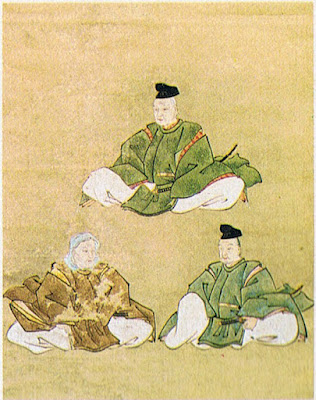 奥州藤原氏三代の肖像 上が初代藤原清衡、 右が二代、基衡、 左が三代、秀衡 (毛越寺所蔵) Portrait of Ōshū Fujiwara-shi : Northern Fujiwara the third Generation The top is the first Fujiwara no Kiyohira, the right is the second, Motohira, and the left is the third, Hidehira. (Held Mōtsū-ji Temple) 画像は下記より / This from below |
C. ハスの花 / Lotus Flowers
1950年、泰衡の首桶から100個あまりのハスの種子が発見されました。
泰衡没から811年後、種子の発見から50年後の2000年には開花し、
ハスの花は中尊寺の讃衡蔵に保存されました。
中尊寺では、このハスを "中尊寺蓮" とよび、境内の池に栽培しています。
若い泰衡が様々な状況下で決断を迫られたことが察しされ、胸が痛みました。
そして、ここには記載しませんでしたが、彼は酷い殺され方をしたので、私は非常に気の毒に思っていました。
ですが、このハスの花のエピソードで少し気持ちが救われました。
 |
| 中尊寺のハス池 Lotus Pond in Chusonji Temple 画像は下記より/ This from below ★ |
Lotus Flowers
In 1950, about 100 lotus seeds were discovered in a bucket with Yasuhira's head.
Some bloomed in 2000, 811 years after the death of Yasuhira and 50 years after the discovery of the seeds, and the lotus flower is preserved in the Sankozo ; Museum of Chusonji Temple.
At Chusonji, this lotus is called "Chusonji Lotus" and is cultivated in
a pond in the precincts.
It was painful to see that young Yasuhira was forced to make decisions under various circumstances.
And although I do not describe here about his death, I was very sorry for his terrible killing.
However, the lotus episode helped me a little.
 |
| "古代蓮" 岩手県紫波郡紫波町にある吾郎沼に咲く"古代蓮"。 2002年に中尊寺から移植され、毎年7月に花が咲きます。 "Ancient Lotus" "Ancient Lotus" blooms in Goronuma Pond in Shiwa Town, Shiwa District, Iwate Prefecture. It was transplanted from Chūson-ji Temple in 2002 and blooms every July. 画像は下記より / This from below ★ |
4) 経蔵 / Kyōzō
下記、寺のサイトより
"「中尊寺建立供養願文」によると、当初は「2階瓦葺」でした。
建武4年(1337)の火災で上層部を焼失したと伝えられていますが、おそらくは古材をもって再建されたものでしょう。
当初のあざやかな彩りや飾りは長い歳月によってすっかり洗い流されていて、金色堂とは対照的な趣があります。"
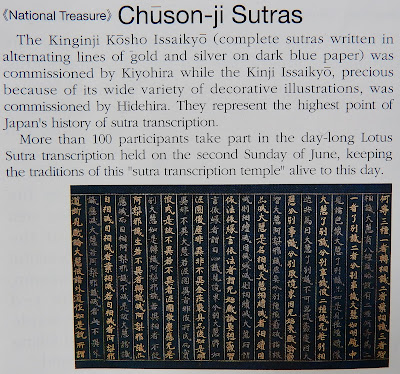 下記、寺のサイトより |
| ご本尊騎師文殊菩薩(重文)と三方の経棚に納められていた 紺紙金字一切経(国宝)は宝物館「讃衡蔵」に移され、 新たな騎師文殊菩薩が安置されています。(重文)"  紺紙金字一切経 Complete Buddhist scriptures on deep blue paper with gilt letters (紺紙金字一切経, konshikonji issaikyō) or Chūson-ji Sutras (中尊寺経, Chūson-ji kyō) It was in the Kyōzō, nowadays it is displayed in Sankozo ; Museum. 画像は下記より / This from below ★  |
5) 金色堂旧覆堂
Former Golden Hall Protecting Shell
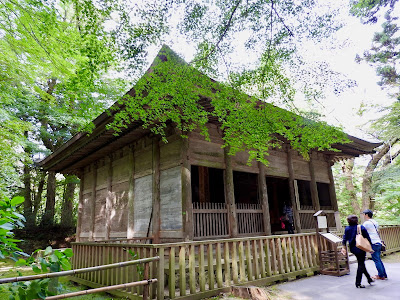 |
金色堂旧覆堂 Former Golden Hall Protecting Shell |
 |
| 内部 'がらんどう'...と言う印象でした。 確かに空っぽです...。 ここにすっぽり金色堂があり、それが抜けたためですね。 Inside I had the impression that it was 'Hollow' ... It's definitely empty ... This is because it used to hold the Golden Hall, and it's gone. 画像は下記より/ This from below ★ |
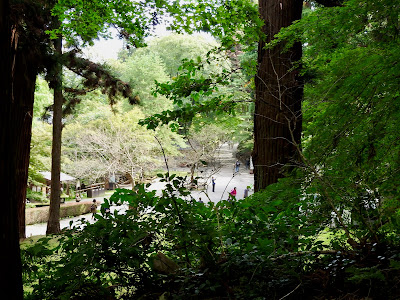 |
| 参道を見る / Looking at the Approach |
次のセクションも中尊寺についてです。
The next section is also about Chūson-ji Temple.





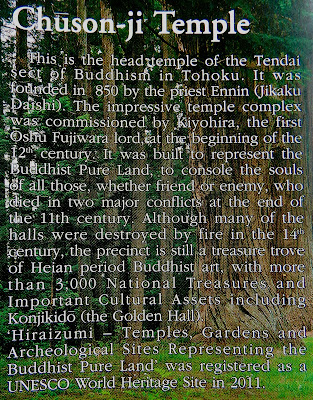



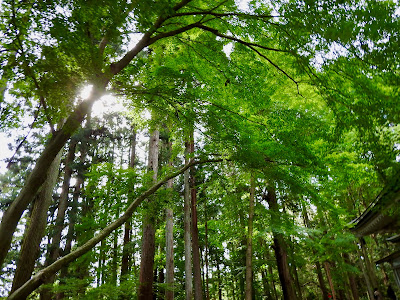






0 件のコメント:
コメントを投稿